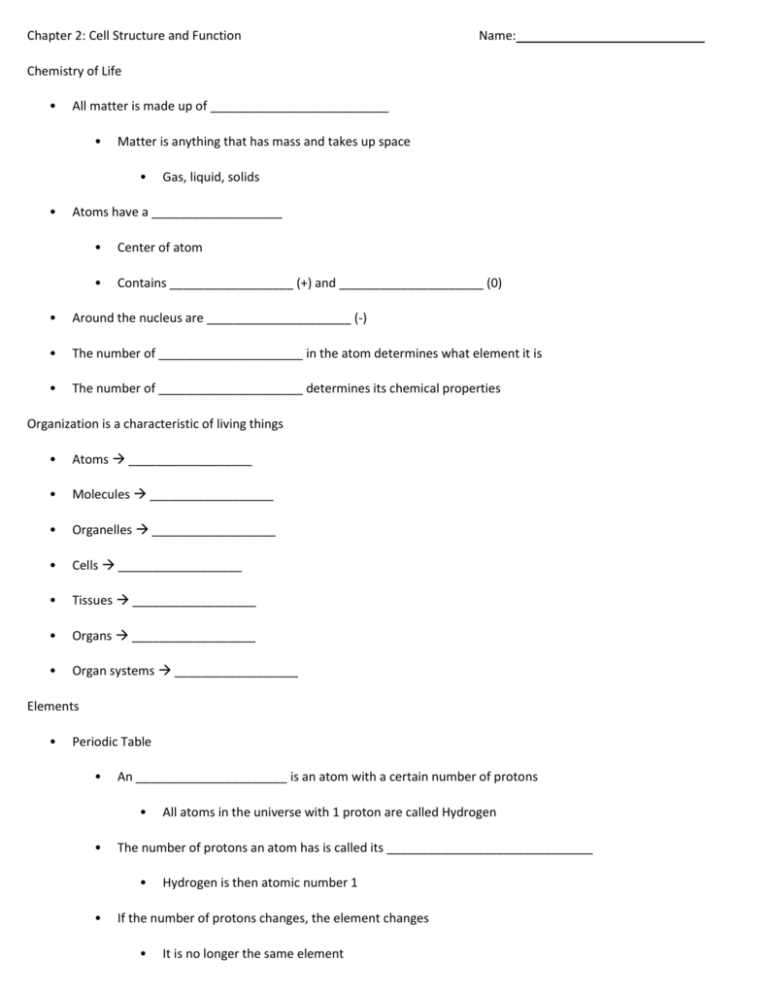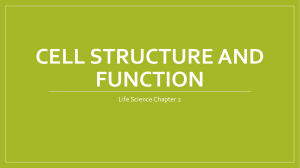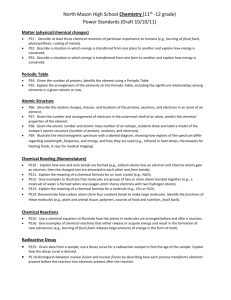Notes
advertisement

Chapter 2: Cell Structure and Function Name: Chemistry of Life • All matter is made up of __________________________ • Matter is anything that has mass and takes up space • • Gas, liquid, solids Atoms have a ___________________ • Center of atom • Contains __________________ (+) and _____________________ (0) • Around the nucleus are _____________________ (-) • The number of _____________________ in the atom determines what element it is • The number of _____________________ determines its chemical properties Organization is a characteristic of living things • Atoms __________________ • Molecules __________________ • Organelles __________________ • Cells __________________ • Tissues __________________ • Organs __________________ • Organ systems __________________ Elements • Periodic Table • An ______________________ is an atom with a certain number of protons • • The number of protons an atom has is called its ______________________________ • • All atoms in the universe with 1 proton are called Hydrogen Hydrogen is then atomic number 1 If the number of protons changes, the element changes • It is no longer the same element • Electron and neutron numbers can change in an element • A neutral atom has ____________________________ of protons and neutrons • • If an atom loses or gains electrons, it gains a ___________________ • If it gains an electron, it becomes more negative (more of a negative charge) • If it loses electrons, it becomes positive (less negative charges) Example • Sodium (Na) is atomic number 11 because it has 11 protons • When neutrally charged, it will have 11 electrons • However, Sodium really wants to lose an electron • When it loses that electron, it will have 11 protons and 10 electrons • It will be positively charged • • Chlorine (Cl) is atomic number 17 because it has 17 protons • Has 17 electrons when neutral • However, it really wants one more electron (again, not discussed here) • When it gains an electron, it will have 17 protons and 18 electrons • • Charged atoms are called _______________________ It is negatively charged Like magnets, ______________________________________ • Sodium and chlorine attract and form sodium chloride (NaCl) • Also called table salt Elements in Organisms • __xygen~61%, __arbon~23%, __ydrogen~10%, __itrogen~2.6%, ____lcium~1.5%, __hosphorus~1.1%, Other-Less than 1% • Called Trace elements • • Still important, but found in lower amounts How to remember: __ur C__ooks __ave __o ___kes or __ies • 1st letters are the chemical symbol of the element Atoms to molecules • Salt is an example of a _______________________ • • • Molecules are made up of atoms bonded together __________________ is the most important molecule to organisms • Water is required for many of the chemical reactions that take place in organisms • Cells are mostly water. Large molecules are called _________________________________ • 4 important ones for life: Lipids, Proteins, Carbohydrates, Nucleic Acids Properties of Water • Water is a __________________________ • It has areas of positive charge (the hydrogen atoms) and areas of negative charge (the oxygen atom) • This __________________________________ • Sodium and chloride break apart easily in water • • • Salt water As do sugar molecules Water molecules also like to bond to other water molecules (called ________________________) • Causes _____________________________________ Structure of Macromolecules • The 4 main macromolecules are _______________________________ • Made up of chains of smaller molecules • Think train made up of carts • The large molecules are called __________________ (poly=many)-The train • The smaller molecules are called ________________ (mono=one)-The carts • The monomers are held together by _______________ Lipids • ______________, oils, steroids • Do not dissolve in water • Make up the cell membrane • ______________________________ Proteins • Important for many ________________________ • Also help build ____________________________ • Monomers are ____________________________ • Proteins have a ___________________________ that determines their role • ___________________ are important proteins that assist with chemical reactions Carbohydrates • ____________________________- • Sugars, starches Nucleic Acids • The most important macromolecules • Monomers are ______________________ • ________, _________, and ________ are all nucleic acids • DNA is the material passed from parents to children and contains the instructions for the organism’s features • RNA is used to manufacture proteins • ATP provides the cell with energy to do nearly everything The Cell Theory • Recall: Theory in science=____________________________ • Explains what cells are, what they do, and where they come from • ___ scientists contributed: Robert Hooke, Matthias Schleiden, Theodor Schwann, and Rudolf Virchow (Guaranteed Matching question on Test) Robert _____________________ • 1635-1703 English philosopher and scientist • Looked in a microscope at cork and discovered small spaces • • _________________________ Laid the foundation for cell theory more than 100 years before others Matthias _______________________ • 1804-1881 German botanist (studied plants) • Discovered that ___________________________________- Theodor ________________________ • 1810-1882 German physiologist (studied how the body works) • Discovered that __________________________________________ Rudolf _________________________ • 1821-1902 German doctor • Discovered that _____________________________________ How do we see cells? • Microscopes • • The ones we use are called _________________________________ • Pass light through the image • The light is then collected by 2 different lenses and becomes magnified Antonine van _____________________________ • Improved the microscope so that it could be used in biology • First to observe microorganisms that can not be seen without one 1. 12. 11. 2. 10. 3. 9. 4. 8. 5. 7. 6. 1. Ocular Lens (Eyepiece) • This is what you ____________________ to see the image. • It contains a lens (usually 10x magnification) 2. Arm • Structural piece • • Holds the parts of the microscope in the proper places. THE ARM IS ______________________________ • Never carry the microscope by the arm alone. • _______________________________________________________________________ • Microscopes are very expensive. Use the utmost care when transporting it. 3. Stage • This is the flat portion where you _____________________________________. • A hole in the stage allows light to pass through the slide 4. Course Focus • _________________________________________________ • Doing so brings the object into focus. • • Move it until the image becomes visible. It will still be a bit blurry. Note about the Course Focus: Using the course focus to try to get a better image could result in the stage moving the slide up into the objective. This could crack the slide and/or objective lens, and could be a VERY expensive mistake. 5. Fine Focus • Makes _________________________________ to the stage. • Once you have found the image, use the fine focus to make it clear. 6. Base • _________________________________________________ • Structural and support. • Remember, one hand underneath the base and the other holding the arm. 7. Light Source • A _________________________ • Sends light through the slide. 8. Diaphragm • Allows you to _______________________________________________ that comes through. 9. Slide Clips • Little metal pieces that __________________________________________ • Make sure that the slide is under the clips. • You do not want the slide moving after you have just found the image 10. Objectives • Each is a different lens that _________________________________________ • Most microscopes have several of these ranging from 4x to 200x • Begin on the lowest objective to find the image, then increase to zoom it in. 11. Rotating Nosepiece • ___________________________________________ • Twist to change magnification. 12. Body Tube • Holds ___________________ Magnification • Magnification is the ______________ of the magnifications of the eyepiece and the objective lenses • • Eyepiece x Objective= Total Magnification Example: Eyepiece 10x and objective 20x • 20x10=__________________magnification Cell Types • 2 major categories of cells • • • __________________________ Cells • Bacteria and Archaea • ________________________, including nucleus ___________________________ Cells • Protists, Plants, Fungi, and Animals • ______________________________________, including nucleus • Much more complicated _________________________________ (small organs) • Like organs to our body • Each does a job for the cell • All work together Protection and Support • • ___________________ have a __________________________ • Flexible boundary between cell and its environment • Made up of proteins and lipids • ____________ the cell, gives it _____________, and allows _____________________ to enter and exit the cell ________________________, and some fungi, protists, and bacteria, also have a cell wall • Outside of the cell membrane • Very ________________ • More protection Cell Appendages • Some cells have things attached to them that do a job • _______________________ are whip-like structures that work as a motor for the cell • Spins and allows the cell to move • • • Not common in humans except on sperm, very common in unicellular organisms Usually ___________________ ______________ are numerous, hair-like structures • Work like a row team and move cell • Also work to remove foreign materials • • Found in __________________. Removes dust, pollen, and other materials before they reach the lungs __________________________ on cells that contain them Cellular Structure • • Cells are filled with a jelly-like substance called __________________________ • Function: _______________________ for the cell and _____________________________ in place • Found in: ________________________ Throughout the cytoplasm are proteins that act as “bones” • Called the _________________________________ • • Does similar job to our skeleton • Function: __________________, _______________, allows some cells to _______________ • Found in ___________________________________ ______________________ • Function: _________________________________ • Found in __________________________ (very few plants, fungi, protists have them) • Made of the same material as cytoskeleton The Nucleus • Function: The __________________________ for the cell • Function: ______________________________ • The DNA is in the form of chromosomes (more to come later) • Found in _______________________________________ • Also contains another organelle called the _____________________________ • Function: __________________________________ • Found in __________________________________ Manufacturing Organelles • • • ________________________________ • Function: _____________________________________ • Can be ___________________ in the cytoplasm or attached to the rough endoplasmic reticulum (________) • Made in the ___________________________________ • Found in ______________________, prokaryotic and eukaryotic Rough Endoplasmic Reticulum (________) • Studded with ________________________ • Function: _______________________________________ • Found in ________________________________________ Smooth Endoplasmic Reticulum (________) • Function: _______________________ and helps ________________________ from the cell • Found in ____________________________________ Energy Organelles • ________________________________ • The powerhouse of the cell • Function: ___________________________________________, manufactures ________ for use in other processes • Found in ____________________________________________________________ • ________________________ • Function: Convert ____________________________________ • These sugars are used in mitochondria to make ATP • Found in ______________ and some ________________ (also some __________________), never in animals • _____________________________ Processing, Transportation, Cleaning • • • ______________________________________________ • Post office of cell • Function: _____________________________________ • Found in ______________________________________ _________________________________________________ • The mail trucks • Function: ___________________ of proteins and other materials • Found in ____________________________ ________________________________ • The cell’s cleaners • Function: _____________________________ particles in the cell, clean up wastes and broken down cell parts • Found in _____________________________________ Storage and Cell division • _______________________________ • Function: _________________________ such as water, food, wastes • Found in _______________________ • _______________ usually have one large one • • Called _____________________________________ ________________ have many small ones









